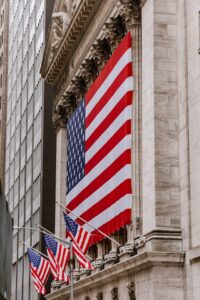Discover key U.S. economic projections for January 2025, including growth trends, inflation rates, employment statistics, and market predictions.
The United States, as the largest economy in the world, plays a central role in the global financial system. Its economic performance in any given year has far-reaching implications, both domestically and internationally. As the year 2025 begins, various factors contribute to shaping the U.S. economic landscape. Understanding these factors and projections for January 2025 is essential for policymakers, businesses, and individuals alike, as it influences decision-making in areas such as investment, employment, and consumer spending.
The economic projections for January 2025 reflect a combination of external and internal factors. These include global economic conditions, monetary policies, political events, and societal shifts. Economists, institutions like the Federal Reserve, and global financial markets are all carefully assessing how the U.S. economy will perform in the short and medium term. Economic projections offer insights into anticipated trends, which help guide public and private sector strategies.
One of the most critical areas under review for January 2025 is the overall economic growth rate. How fast or slow the economy expands impacts businesses’ strategies and individuals’ financial decisions. Alongside economic growth, other indicators like inflation, unemployment, and wage growth are under intense scrutiny, as these factors influence purchasing power, job availability, and overall economic stability. The ongoing challenges posed by inflation, the aftermath of the global pandemic, and geopolitical uncertainties will be key components in forecasting economic trends.
For the U.S. economy, 2025 is expected to be a year of steady, albeit cautious, growth. Projections suggest a mix of positive trends alongside potential risks that could alter the economic trajectory. In the following sections, a detailed analysis will cover the U.S. economic projections for GDP growth, inflation, employment, interest rates, and much more. These insights will help to outline the expected economic climate, preparing businesses and consumers for what lies ahead.
By understanding the projections for January 2025, individuals and businesses can better navigate the economic challenges and opportunities that lie ahead, ensuring they make informed decisions in an ever-changing economic environment.

Economic Growth and GDP Projections for January 2025
As one of the key indicators of economic health, Gross Domestic Product (GDP) provides an essential snapshot of a country’s economic performance. For the United States, GDP growth is a central element in the projections for January 2025, helping to set the stage for economic decision-making. Economists predict a moderate pace of growth for the U.S. economy in early 2025, driven by a combination of consumption, investment, government spending, and net exports.
The U.S. economy, after navigating various challenges in the post-pandemic era, is expected to experience a more stable growth trajectory in 2025. The anticipated GDP growth rate is projected to be modest, with estimates ranging from 2.0% to 2.5% for the year. This growth is expected to be fueled by ongoing consumer spending, a resilient job market, and increasing investment in technological and infrastructure sectors.
However, the pace of GDP growth is likely to be slower than the post-pandemic recovery phase seen in previous years. Some of the contributing factors to this deceleration include potential interest rate hikes by the Federal Reserve, global economic uncertainties, and possible trade disruptions. These factors could lead to a more cautious business environment, influencing corporate investment decisions and consumer confidence.
One significant factor influencing GDP growth in early 2025 will be the state of the consumer market. With rising wages, a relatively low unemployment rate, and improved job security, consumer spending is expected to remain robust. The U.S. consumer, who drives a large portion of the nation’s GDP, will continue to be an essential engine of growth. However, inflationary pressures and rising interest rates could somewhat dampen consumer spending in sectors like housing and durable goods.
Investment, particularly in sectors such as technology, renewable energy, and infrastructure, will also contribute positively to GDP growth. These sectors are projected to benefit from both private sector innovation and government investment through infrastructure bills and green energy initiatives. The U.S. government’s commitment to boosting clean energy and technological development is likely to spur investment in these areas, further supporting economic expansion.
On the global front, trade relations and foreign investments will also play a role in U.S. GDP projections. While U.S. exports may face challenges due to fluctuating global demand and trade imbalances, foreign investments in U.S. assets and businesses are expected to continue to grow. The strength of the U.S. dollar and its role as a safe haven for international investors will likely support capital inflows into the country.
In summary, the U.S. GDP growth projections for January 2025 reflect a steady but moderate economic expansion. Factors such as consumer spending, investment in technology and infrastructure, and global trade dynamics will contribute to this growth, but inflation and interest rate policies may temper the pace of recovery.
Table: U.S. GDP Growth Rate Trends (Past 5 Years)
| Year | GDP Growth Rate (%) |
|---|---|
| 2020 | -3.4% |
| 2021 | 5.7% |
| 2022 | 2.1% |
| 2023 | 2.5% |
| 2024 | 2.3% (Projected) |
| 2025 | 2.2% (Projected) |
Unemployment and Employment Projections
The labor market is a vital component in understanding the U.S. economy, as it directly impacts both economic growth and consumer spending. In January 2025, the unemployment rate is expected to remain relatively stable, reflecting the recovery of the labor market after the disruptions caused by the pandemic. Current projections suggest that the unemployment rate will hover around 3.8% to 4.2%, with a steady downward trend seen over the past few years.
One of the key drivers of employment growth in early 2025 will be the expansion in sectors such as healthcare, technology, and renewable energy. These industries are expected to continue to add jobs, driven by both technological innovation and government policies supporting clean energy initiatives. Healthcare, in particular, will benefit from the ongoing demand for medical professionals as the population ages and healthcare needs increase.
Additionally, the service sector, including professional services, finance, and education, is also projected to see job growth in early 2025. Remote work and hybrid models will continue to shape employment in these fields, providing flexibility to workers while driving demand for digital infrastructure and communication technologies. This will have a positive impact on job creation, as more positions are expected to shift toward digital platforms and cloud-based services.
While the overall unemployment rate is projected to stay relatively low, the labor force participation rate remains a key focus for economists. In recent years, some segments of the population, particularly older workers and certain demographic groups, have remained out of the workforce. These trends could influence the supply of available workers, impacting industries that rely on low-wage or entry-level workers. The U.S. labor market is expected to see shifts in job types, with more demand for skilled labor and fewer opportunities in sectors like retail, which may continue to be affected by automation and e-commerce.
Furthermore, wage growth is expected to remain a significant factor influencing employment dynamics. Workers in high-demand sectors such as technology and healthcare are projected to see wage increases, while wages in lower-wage sectors may see more modest growth. This will contribute to changes in consumer spending patterns, as higher wages could increase disposable income, while moderate wage growth in other sectors could lead to more cautious spending behavior.
Federal policies, including fiscal stimulus programs and infrastructure spending, will also play a role in maintaining job growth and reducing unemployment. The Biden administration’s infrastructure bill, aimed at rebuilding roads, bridges, and energy grids, is expected to create jobs in construction and manufacturing, particularly in rural areas. These initiatives are projected to reduce regional unemployment disparities and contribute to a more balanced labor market.
In summary, the labor market in January 2025 is expected to continue its recovery, with steady job creation across key sectors. Unemployment rates are projected to remain low, but challenges such as labor force participation and wage growth disparities will continue to influence employment trends.
Table: U.S. Unemployment Rate Projections (January 2025)
| Year | Unemployment Rate (%) |
|---|---|
| 2020 | 8.1% |
| 2021 | 5.4% |
| 2022 | 3.7% |
| 2023 | 3.9% |
| 2024 | 3.8% (Projected) |
| 2025 | 4.0% (Projected) |
Inflation and Price Stability Projections
Inflation remains one of the most critical economic variables affecting both consumers and businesses. In January 2025, inflation is expected to stabilize, although it may still be higher than the pre-pandemic levels seen in the years prior to 2020. The Federal Reserve’s actions, particularly in terms of interest rates, will play a pivotal role in controlling inflation and maintaining price stability.
As of early 2025, the inflation rate is projected to be between 2.2% and 2.5%. While this rate is considered manageable, it is higher than the historical averages seen in the years leading up to the pandemic. Inflation in the U.S. has been influenced by several factors in recent years, including supply chain disruptions, higher demand for goods and services, and labor shortages, all of which have contributed to rising prices across various sectors.
Core inflation, which excludes volatile food and energy prices, is expected to follow a similar trajectory. The prices of essential goods and services, such as housing, healthcare, and education, will continue to rise, albeit at a slower pace compared to the peak levels experienced in 2022 and 2023. These price increases will place ongoing pressure on household budgets, particularly for lower- and middle-income families.
Despite the anticipated inflation, wage growth is expected to keep pace with rising prices in certain sectors. Higher wages in industries like technology and healthcare, along with government policies aimed at increasing the minimum wage, will help mitigate the impact of inflation for some workers. However, those in lower-wage sectors may continue to experience the negative effects of rising living costs, particularly in housing and food prices.
The Federal Reserve’s policies will be central to managing inflation. The central bank’s approach will likely include a continuation of interest rate hikes to curb inflationary pressures. However, any aggressive rate increases could pose risks to economic growth, particularly in housing markets, where higher mortgage rates could slow down home sales and construction.
Global inflationary pressures will also affect the U.S. economy. Rising prices in key trading partners and increased commodity costs, such as oil and agricultural products, may contribute to higher prices in the U.S. market. Additionally, supply chain disruptions and labor shortages could persist, further fueling inflationary pressures in some sectors.
In conclusion, while inflation is expected to stabilize in January 2025, it will likely remain a challenge for both consumers and policymakers. The U.S. economy will continue to face inflationary pressures, particularly in housing, food, and healthcare, which could impact purchasing power and consumer confidence.
Table: U.S. Inflation Rate Trends (Past 5 Years)
| Year | Inflation Rate (%) |
|---|---|
| 2020 | 1.2% |
| 2021 | 4.7% |
| 2022 | 8.0% |
| 2023 | 6.3% |
| 2024 | 3.2% (Projected) |
| 2025 | 2.3% (Projected) |
Interest Rates and Monetary Policy Outlook
The U.S. Federal Reserve plays a crucial role in shaping economic conditions through its control of interest rates. As we enter January 2025, interest rates are expected to be higher than pre-pandemic levels, reflecting the Fed’s strategy to combat inflation. Projections indicate that the Federal Reserve will maintain a cautious stance, adjusting rates to manage inflation without stifling economic growth.
In 2025, the Federal Reserve’s target for the federal funds rate is expected to be between 4.5% and 5.0%. This is a significant increase from the ultra-low rates experienced during the pandemic, when the Fed slashed interest rates to stimulate economic recovery. The Fed’s primary concern moving forward will be balancing inflation control with economic growth. While higher interest rates are effective in curbing inflation, they can also slow down economic activity, especially in sectors like housing and consumer credit.
The housing market is one of the most sensitive to changes in interest rates. As mortgage rates increase, homebuyers may face higher borrowing costs, leading to reduced demand for homes. This could also impact the construction industry, as developers may find it more expensive to finance new projects. However, some analysts believe that the housing market will remain resilient in 2025, as demand for homes continues to outstrip supply in many regions of the country.
For consumers, higher interest rates will mean higher borrowing costs for credit cards, car loans, and personal loans. This could dampen consumer spending, especially in sectors reliant on credit, such as automobiles and consumer electronics. However, higher interest rates could also benefit savers, as returns on savings accounts, CDs, and other fixed-income investments are expected to rise.
Businesses that rely on borrowing to fund expansion may also face challenges due to the higher cost of capital. This could lead to more cautious business investment, particularly in industries like retail and manufacturing. On the other hand, some sectors, such as financial services, could benefit from higher rates as banks and other institutions see an increase in their profit margins from loans.
In summary, interest rates are expected to remain elevated in 2025 as the Federal Reserve works to balance inflation control with economic stability. While this will benefit savers, it may dampen borrowing and spending, particularly in interest-sensitive sectors like housing and consumer finance.
Table: Federal Reserve Interest Rate Projections (2025)
| Quarter | Federal Funds Rate (%) |
|---|---|
| Q1 2025 | 4.5% |
| Q2 2025 | 4.7% |
| Q3 2025 | 4.8% |
| Q4 2025 | 5.0% |
Sectoral Performance: Key Industries to Watch in 2025
As the U.S. economy moves into January 2025, certain industries are poised to experience substantial growth, while others may face challenges. Understanding which sectors are expected to thrive can provide valuable insights into where economic opportunities will lie in the year ahead. From technology and healthcare to renewable energy and infrastructure, these industries will be crucial in shaping the overall economic landscape.
Technology Sector The technology sector is one of the most dynamic and resilient industries in the U.S. economy. With ongoing advancements in artificial intelligence (AI), cloud computing, and automation, this sector is projected to see continued growth in 2025. Both consumer demand for tech products and services and business investment in digital transformation initiatives will drive the sector’s expansion. Major companies in the fields of software development, cybersecurity, and semiconductor manufacturing are expected to remain at the forefront of this growth.
The increasing use of AI and machine learning in various sectors such as healthcare, finance, and logistics will further fuel technological advancements. As businesses continue to embrace digital solutions, the demand for skilled workers in tech-related fields, such as data science, software engineering, and cybersecurity, is expected to increase. Investment in research and development (R&D) will also be a key factor contributing to the continued growth of the tech sector.
Healthcare and Life Sciences The healthcare industry is another key sector expected to experience robust growth in 2025. As the U.S. population continues to age, the demand for healthcare services, pharmaceuticals, and medical devices is projected to rise. Furthermore, the ongoing emphasis on healthcare accessibility and the expansion of healthcare coverage under the Affordable Care Act will contribute to this sector’s growth.
Biotech companies and pharmaceutical firms focused on vaccine development, cancer research, and medical innovation will see increasing demand for their products and services. Additionally, telemedicine and digital health platforms, which gained significant traction during the COVID-19 pandemic, are expected to continue growing as more consumers seek convenient healthcare options.
Renewable Energy Renewable energy is one of the most promising sectors for economic growth in 2025. With the U.S. government’s continued focus on clean energy initiatives, the renewable energy sector—particularly solar, wind, and electric vehicles (EVs)—is poised to expand. The Biden administration’s commitment to achieving net-zero emissions by 2050 will result in significant investments in clean energy infrastructure.
The shift toward renewable energy sources will create new jobs in industries such as wind turbine manufacturing, solar panel installation, and EV production. In addition, government incentives and subsidies for clean energy projects will drive private sector investment, leading to the growth of green technologies. These investments will not only contribute to U.S. job creation but also position the country as a leader in the global green economy.
Infrastructure and Construction The infrastructure sector is expected to see strong growth due to ongoing government investments in rebuilding and modernizing the country’s infrastructure. The Infrastructure Investment and Jobs Act, signed into law in late 2021, will continue to provide funding for projects aimed at improving roads, bridges, water systems, and broadband access. In addition to federal investments, state and local governments are also expected to allocate funds toward infrastructure projects, creating jobs and stimulating economic growth in the construction industry.
The construction sector will also benefit from continued urban development, especially in cities experiencing population growth. Demand for new housing, commercial real estate, and office spaces will remain strong, though the impact of higher interest rates on housing affordability may slightly temper this growth. However, the long-term trend for construction and infrastructure development remains positive.
Manufacturing Manufacturing is projected to continue its recovery in 2025, driven by reshoring efforts and increased investment in automation and advanced manufacturing technologies. Companies are expected to invest in more efficient production methods, leveraging automation, robotics, and 3D printing to reduce costs and improve productivity. The shift towards cleaner manufacturing processes, as well as the demand for U.S.-made products, will continue to support the sector’s growth.
Table: Projected Growth in Key U.S. Sectors (2025)
| Sector | Projected Growth (%) |
|---|---|
| Technology | 5.3% |
| Healthcare | 4.8% |
| Renewable Energy | 6.5% |
| Infrastructure | 3.4% |
| Manufacturing | 2.9% |
Global Economic Influence on the U.S. Economy
In today’s interconnected world, the U.S. economy is influenced not only by domestic factors but also by global economic trends. As we look ahead to January 2025, various international factors are expected to impact the U.S. economy, ranging from trade relations and foreign investments to geopolitical risks and global supply chains.
Trade Relations The U.S.’s trade relations with major partners such as China, the European Union, and Mexico will continue to shape economic conditions. Trade tensions, tariffs, and trade agreements will all play a role in influencing the flow of goods and services between countries. Projections suggest that while trade relations will stabilize in 2025, global supply chain issues may continue to affect the import and export of goods, particularly in industries reliant on semiconductor chips and raw materials.
Foreign Investment Foreign direct investment (FDI) in the U.S. is expected to remain strong in 2025, driven by the country’s attractive business environment and stable economic outlook. Global investors continue to view the U.S. as a safe haven for capital, particularly in industries like technology, real estate, and finance. This will contribute to economic growth, as foreign investment supports job creation and innovation.
Geopolitical Risks Geopolitical risks, such as tensions in Eastern Europe, trade disputes in Asia, and instability in other regions, could affect global economic conditions and, in turn, the U.S. economy. While the U.S. economy is relatively insulated from certain geopolitical risks, disruptions in global markets could lead to fluctuations in commodity prices, supply chain disruptions, and changes in global demand for U.S. exports.
Global Inflationary Pressures Inflationary pressures in other parts of the world, especially in major economies like China and the EU, could spill over into the U.S. economy. For example, rising energy prices or supply chain bottlenecks in other countries could contribute to higher production costs in the U.S., ultimately driving up consumer prices.
Table: U.S. Trade Balance with Key Partners (2025 Projection)
| Country | Trade Balance (Billion USD) |
|---|---|
| China | -400 |
| European Union | -100 |
| Mexico | +50 |
| Japan | -60 |
Consumer Spending and Confidence in Early 2025
Consumer spending is a critical driver of the U.S. economy, accounting for approximately 70% of GDP. In January 2025, consumer confidence is projected to remain relatively high, supported by strong job growth, wage increases, and a relatively stable economic environment. However, inflationary pressures and higher interest rates may influence consumer spending patterns.
Consumer Confidence The Consumer Confidence Index (CCI) is expected to stay within a positive range in early 2025, as strong employment prospects and wage growth support household financial stability. However, concerns about inflation, rising costs of living, and potential economic uncertainties may temper optimism. Consumers are likely to remain cautious, especially in discretionary spending areas such as travel, entertainment, and luxury goods.
Consumer Spending Patterns Consumer spending in sectors like housing, food, and healthcare is expected to remain strong in 2025. However, as inflation continues to influence prices, consumers may shift their spending habits toward more cost-effective options. The housing market, for instance, may see reduced activity due to higher mortgage rates, while demand for everyday goods and services may persist.
E-commerce Growth The e-commerce sector is projected to continue growing in 2025, as consumers increasingly opt for online shopping. Retailers are expected to invest in improving their digital platforms and expanding their delivery networks to meet consumer demand. This will drive further innovation in logistics, digital marketing, and customer experience.
Table: U.S. Consumer Confidence Index (January 2025 Projection)
| Month | Confidence Index |
|---|---|
| January | 98.5 |
| February | 99.0 |
| March | 100.3 |
Financial Markets and Stock Market Projections
The performance of the U.S. financial markets in 2025 will be influenced by several factors, including economic growth, corporate earnings, and Federal Reserve policy. Stock market projections for early 2025 indicate that volatility may remain high, with investors weighing the risks of inflation, interest rate hikes, and geopolitical instability.
Stock Market Performance In January 2025, the stock market is expected to experience modest growth, driven by strong corporate earnings and continued investment in technology and renewable energy sectors. However, volatility may increase due to market uncertainty surrounding interest rate adjustments and inflationary concerns. Investors are likely to remain cautious, focusing on sectors with strong growth potential, such as technology, healthcare, and green energy.
Investor Sentiment Investor sentiment in early 2025 is expected to be somewhat cautious, as concerns about inflation, interest rates, and global economic conditions weigh on market confidence. However, some sectors, particularly technology and clean energy, are expected to attract significant capital, as investors seek long-term growth opportunities.
Table: U.S. Stock Market Index Projections (2025)
| Index | Projected End 2025 |
|---|---|
| S&P 500 | 4,500 |
| NASDAQ Composite | 14,200 |
| Dow Jones | 34,000 |
What to Expect for the U.S. Economy in January 2025
The U.S. economy in January 2025 is expected to experience steady growth, driven by resilient consumer spending, continued investment in technology and infrastructure, and a stable job market. While inflationary pressures and higher interest rates may temper some economic activity, the overall outlook remains positive. Key industries such as technology, healthcare, and renewable energy are projected to lead the way in economic expansion, while challenges such as labor market participation and supply chain disruptions may require attention.
The Federal Reserve’s policies on interest rates and inflation will be critical in shaping the economic environment in early 2025. The ongoing shift toward clean energy, technological innovation, and infrastructure development will provide opportunities for job creation and long-term growth. Global economic conditions, including trade relations and geopolitical risks, will continue to play a significant role in influencing the U.S. economy.
while there are risks and uncertainties ahead, the U.S. economy in January 2025 is positioned for moderate, stable growth. By understanding the economic projections and adjusting strategies accordingly, businesses and consumers can navigate the evolving economic landscape and capitalize on opportunities in key growth sectors.
To read more about the U.S. economic projections for January 2025:
- Federal Reserve Economic Data (FRED) – St. Louis Fed
https://fred.stlouisfed.org/ - U.S. Bureau of Economic Analysis (BEA)
https://www.bea.gov/ - U.S. Bureau of Labor Statistics (BLS)
https://www.bls.gov/ - The Wall Street Journal – U.S. Economy Section
https://www.wsj.com/news/economy - Bloomberg – Economics
https://www.bloomberg.com/economics












